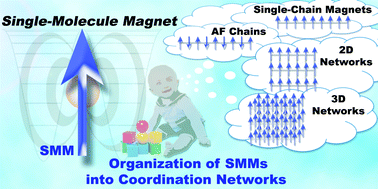Controlled association of single-molecule magnets (SMMs) into coordination networks: towards a new generation of magnetic materials†
Abstract
The field of molecular magnetism has rapidly expanded since the discovery of single-molecule magnets (SMMs) at the beginning of the 1990s. Numerous SMMs have been studied and a broad community currently works on these systems to improve their magnetic characteristics. However, it has also become an important strategy to diversify a part of our research activity toward the organization of these magnetic molecules in order to move closer to future applications. One of the possible ways is to utilize SMMs as molecular building blocks and assemble them with the help of coordination chemistry. This strategy presents a significant challenge since the intrinsic magnetic properties of the parent SMMs can be modified, which consequently also provides a unique opportunity to investigate new behaviours at the frontier between SMMs and classical bulk magnets. Furthermore, the design of systems with “enhanced” SMM properties or magnet behaviour is theoretically possible by choosing coordinating linkers that could favour an effective ferromagnetic arrangement of the SMMs. In this perspective article, we will give an overview of the known networks based on SMMs with an emphasis on the synthetic strategies, magnetic properties, and finally possible routes to a new generation of molecular magnetic materials.


 Please wait while we load your content...
Please wait while we load your content...